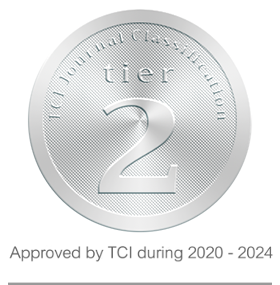Postharvest Management by Drying Method and Storage Period for Controlling the Contamination of Aspergillus flavus and Aflatoxin B1 in Peanuts
Keywords:
Contamination, Protein, FatAbstract
Peanuts are often found as contaminants Aspergillus fungi and aflatoxin B1 (AFB1), which cause liver cancer. Thus, this study aimed to determine the appropriate method for drying peanut to minimize the contamination of A. flavus and AFB1 in peanut. Three treatments were tested viz. 1) Pods (immediately striped from the peg) were sorted for quality before being dried on clean pallet for 7 days, 2) Bundles of peanut stem was turned up (pods on top) and dried at field for 1 day. Then, pods were removed from the peg and dried on cement ground for 6 days, and 3) Pods were dried on cement ground for 7 days. The moisture contents were below 9%, whilst contamination of A. flavus and AFB1 from all three methods were not significantly different. AFB1 were less than maximum level of aflatoxin (20 µg/kg). After that, dry peanuts were stored at ambient temperature for 6 months and determined for the contents of AFB1, protein and fat 2 months interval. There was no significantly different in amount of AFB1 as well as protein and fat between peanut from three drying methods. All testing treatments found that the AFB1 contamination did not exceed the requirements for peanut kernels. In addition, after storage for 6 months the peanuts from drying method no.2 were detected AFB1 with the least level 3.2 µg/kg, followed by method no.1 and no.3 with the levels 4.8 and 5.3 µg/kg, respectively. Moreover, the protein were found at the levels of 25.4% and fat contents 41.5%, which were decreased.
References
Agricultural Research Development Agency (Public Organization). 2016. Maize, soybean, mungbean and peanut: Direction of Thai economic crops in ASEAN. Bangkok: Pornsup printing co., ltd.
Department of Agricultural Extension. 2023. Peanut. Situation of crop production year 2019/2020. Bureau of Agricultural Commodities Promotion and Management. Available from: http://www.agriman.doae.go.th/home/news/2564/44peanut.pdf. [accessed on October 13, 2023]
Department of Agriculture. 2009. Information system of peanuts. Available from: http://it.doa.go.th/vichakan/news.php? newsid=32. [accessed on April 13, 2022]
Embaby, E.M. and M.M. Abdel-Galel. 2014. Detection of fungi and aflatoxins contaminated peanut samples (Arachis hypogaea L.). Journal of Agricultural Technology 10(2): 423-437.
Kaaya A.N. and W. Kyamuhangire. 2006. The effect of storage time and agroecological zone on mould incidence and aflatoxin contamination of maize from traders in Uganda. International Journal of Food Microbiology 110(3): 217-223.
Muang Pan Agriculture Office. 2023. Growing peanut knowledge. Available from: http://mueangpan.lampang.doae.go.th. [accessed on October 13, 2023]
N’dede, C.B., C.M. Jolly, S.D. Vodouhe, and P.E. Jolly. 2012. Economic risks of aflatoxin contamination in marketing of peanut in Benin. Economics Research International (2012) Article ID 230638.
National Bureau of Agricultural Commodity and Food Standards. 2010. Good agricultural practices for peanuts. Thai Agricultural Standard (TAS 4900-2553). Published in the Royal Gazette Vol.127 Section 147D Special, Dated 21 December B.E. 2553 (2010).
National Bureau of Agricultural Commodity and Food Standards. 2014. Peanut kernel: maximum level of aflatoxin. Thai Agricultural Standard (TAS 4702-2014). Published in the Royal Gazette, Announcement and General Publication Volume 131, Special Section 246 (Ngo), Dated 4 December B.E. 2557 (2014).
Office of Agricultural Research and Development Region 3. 2017. Technology of peanut production in the upper Northeastern region. New knowledge information year 2017. Available from: http://oard3.doa.go.th/KM2560/KM21092560.pdf [accessed on April 10, 2019]
Okello, D.K., A.N. Kaaya, J. Bisikwa, M. Were and H.K. Oloka. 2010. Management of Aflatoxins in Groundnuts: A manual for farmers, processors, traders and consumers in Uganda. National Agricultural Research Organisation, Entebbe.
Seangsai S. 2000. Influence of Initial Seed Moisture, Storage and Seed Size Affected the Quality of Peanut Seeds. Thesis. Master of Sciences program, Graduate School, Khon Kaen University.
Souza G.F., S.A.G. Mossini, C.C. Arrotéia, C. Kemmelmeier and M.M. Junior. 2014. Evaluation of the mycoflora and aflatoxins from the pre-harvest to storage of peanuts: a case study. Acta Scientiarum. Agronomy Maringá 36(1): 27-33.
Wongkaew, S. and S. Jogloy. 2011. Aflatoxins in peanuts: a proposed solution. Khon Kaen Agriculture Journal 39 supplement 3: 1-11.
Downloads
Published
How to Cite
Issue
Section
License
Copyright (c) 2024 Songklanakarin Journal of Plant Science

This work is licensed under a Creative Commons Attribution-NonCommercial-NoDerivatives 4.0 International License.



